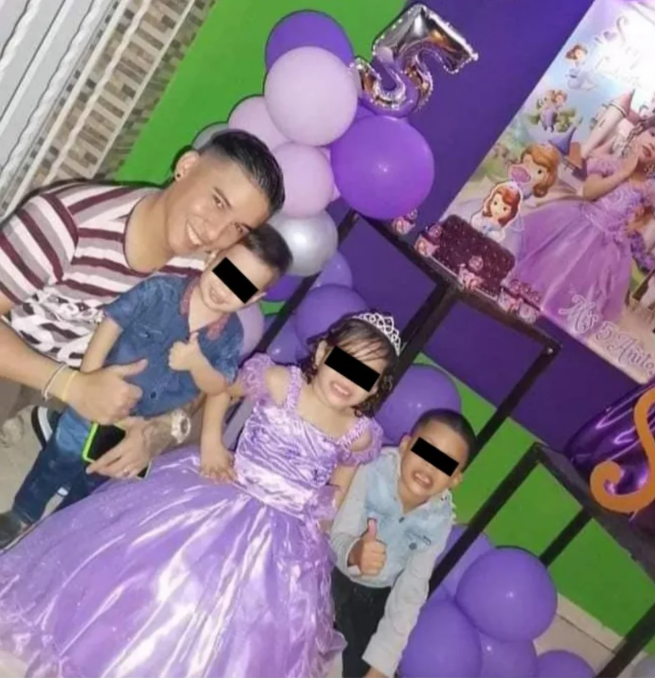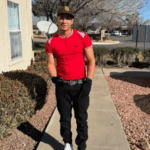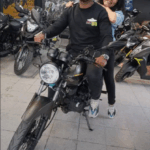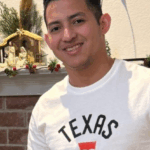Jhon Chacín Gomez, 35, is a very well-known professional tattoo artist in Barranquilla, Venezuela where he lived for many years with his wife and three children, according to his mother-in-law.
In 2024, Jhon left home and traveled through the dangerous Darien gap to the US to work and make money for his family.
“He entered the US with his CBP-One appointment through the Chaparral border on October 8, 2024, along with his traveling group. The others were released, but he was told that he was going to be under investigation for the tattoos,” said Yurliana Chazi, John Chacín’s sister. Yurliana claimed that Jhon’s work as a professional tattoo artist caused him to receive comments from officers inside the detention center.
“He told me he was going to remain in ICE custody for 90 days, because of the tattoos he had on his body. He told me that he was going to be under investigation for that reason, and that there was a lot of discrimination against him and many other Venezuelans for having tattoos on their skin,” she said.
Yurliana was in contact with her brother for more than five months while he remained in a California Detention Center. He was never free in the US.
Jhon told his wife through a video call, after he spent so many months detained in the US, “that he couldn’t take it anymore, that he needed to go back because there was no hope of release or anything”
“They had told him he would be allowed into the U.S. So they took him out, and it turns out he was handcuffed on a plane for 24 hours. But they didn’t let him to the U.S., they just moved him from one detention center in California to another in Texas,” she said.
“He was held in the Texas facility for two or three days. When he realized they had tricked him, that he wouldn’t be allowed into the U.S., and he said ‘no’, he was done.” He wanted to come home to Venezuela, so Jhon requested deportation.”
“Coincidentally, the day his deportation was accepted, President Nicolás Maduro and Diosdado Cabello announced the Plan Return to the Homeland, so they told him he’d be deported to Venezuela,” his wife added.
“That day [in mid March, 2025], he called me happy, excited. He said, ‘I’m leaving, be ready. As soon as I get to Maiquetía Airport [in Venezuela], I’ll contact you so you can help me with expenses.’
So we were waiting for him at the airport,” his wife continued. “But the plane never arrived in Venezuela. Never.”
A day later, while furiously texting with family to try to locate her brother, the news played in the background on Yurliana’s television. As she watched videos of migrants arriving in El Salvador pop up on her screen, she spotted who she believed to be her brother. The images were blurry, but she could identify his tattoos, glasses and recognized his posture.
“It was emotional,” she said. “I don’t know if he’s okay, if he’s eating, how he’s sleeping. He must be nervous and scared.”
Four days later, the family confirmation from DHS that he had been sent to El Salvador. Her only way of getting in touch with him now—by going through channels in El Salvador.
“He knows how much I love him,” she said. “My heart is broken,” Jurliana said.
Articles:
Jhon Chacín Gómez, de 35 años, es un tatuador profesional muy conocido en Barranquilla, Venezuela, donde vivió durante muchos años con su esposa y tres hijos, según su suegra.
En 2024, Jhon dejó su hogar y viajó a través del peligroso Tapón del Darién hacia los Estados Unidos para trabajar y ganar dinero para su familia.
“Entró a los Estados Unidos con su cita CBP-One a través de la frontera de Chaparral el 8 de octubre de 2024, junto con su grupo de viaje. Los demás fueron liberados, pero a él le dijeron que iba a estar bajo investigación por los tatuajes”, dijo Yurliana Chazi, hermana de John Chacín. Yurliana afirmó que el trabajo de Jhon como tatuador profesional hizo que recibiera comentarios de los oficiales dentro del centro de detención.
“Me dijo que iba a permanecer bajo custodia de ICE durante 90 días, por los tatuajes que tenía en su cuerpo. Me dijo que iba a estar bajo investigación por esa razón, y que había mucha discriminación en su contra y de muchos otros venezolanos por tener tatuajes en su piel”, dijo.
Yurliana estuvo en contacto con su hermano durante más de cinco meses mientras permanecía en un Centro de Detención en California. Nunca estuvo libre en los Estados Unidos.
Jhon le dijo a su esposa a través de una videollamada, después de pasar tantos meses detenido en los Estados Unidos, “que ya no podía más, que necesitaba regresar porque no había esperanza de liberación o algo así”.
“Le habían dicho que lo dejarían entrar a los Estados Unidos. Así que lo sacaron, y resulta que estaba esposado en un avión durante 24 horas. Pero no lo dejaron entrar a los Estados Unidos, simplemente lo trasladaron de un centro de detención en California a otro en Texas”, dijo.
“Estuvo detenido en la instalación de Texas durante dos o tres días. Cuando se dio cuenta de que lo habían engañado, de que no lo dejarían entrar a los Estados Unidos, y dijo ‘no’, ya estaba cansado”. Quería regresar a Venezuela, así que Jhon solicitó la deportación.
“Coincidentemente, el día en que se aceptó su deportación, el presidente Nicolás Maduro y Diosdado Cabello anunciaron el Plan Vuelta a la Patria, así que le dijeron que sería deportado a Venezuela”, agregó su esposa.
“Ese día [a mediados de marzo de 2025], me llamó feliz, emocionado. Dijo, ‘me voy, prepárate. Tan pronto como llegue al Aeropuerto de Maiquetía [en Venezuela], te contactaré para que me ayudes con los gastos’. Así que lo estábamos esperando en el aeropuerto”, continuó su esposa. “Pero el avión nunca llegó a Venezuela. Nunca”.
Un día después, mientras enviaba mensajes de texto furiosamente con la familia para tratar de localizar a su hermano, las noticias sonaban de fondo en la televisión de Yurliana. Mientras veía videos de migrantes llegando a El Salvador en su pantalla, vio a quien creía que era su hermano. Las imágenes estaban borrosas, pero pudo identificar sus tatuajes, gafas y reconocer su postura.
“Fue emocionante”, dijo. “No sé si está bien, si está comiendo, cómo está durmiendo. Debe estar nervioso y asustado”.
Cuatro días después, la familia recibió la confirmación del DHS de que había sido enviado a El Salvador. Su única forma de ponerse en contacto con él ahora es a través de canales en El Salvador.
“Él sabe cuánto lo quiero”, dijo. “Mi corazón está roto”, dijo Yurliana.








Leave a Reply